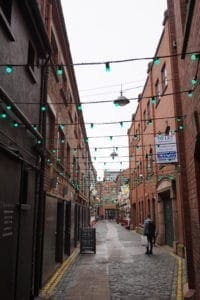The Mud Mosques of West Africa: A Study in Earthen Architectural Splendour
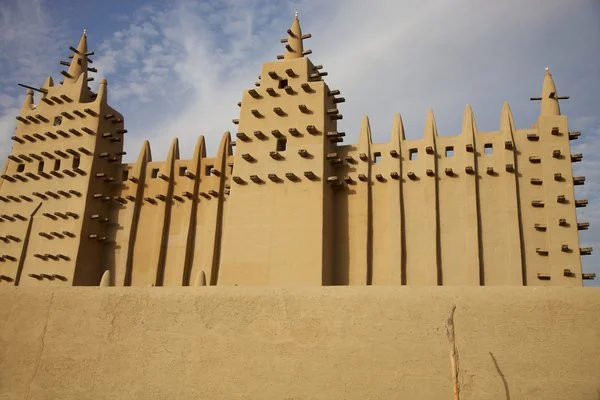
Updated On: March 07, 2024 by Yasmin Elwan
The Mud Mosques of West Africa stand as a testament to the region’s architectural ingenuity and cultural richness. Built from the very earth on which they stand, these structures exude an earthen elegance that reflects both the practical and profound aspects of the Islamic faith in Africa. These mosques are not just places of worship; they are central to the social and religious fabric of their communities, embodying West Africa’s unique geographical context and the adaptable nature of Islamic architecture.
The beauty of these mosques is rooted in their simplicity and the traditional building techniques handed down through generations. Their distinctive architectural features, including the use of mud-brick, timber, and organic materials, set them apart in the architectural world. Despite challenges in preservation and restoration, the mud mosques continue to serve as focal points for religious and social functions, embedding the spirit of the communities within their walls and buttresses.
Mud Mosques of West Africa’s Historical Significance
In the rich tapestry of West African heritage, the mud mosques stand as not only architectural wonders but also as symbols of a period and people steeped in tradition and history. These earthen edifices offer a glimpse into a confluence of religion and local customs that have shaped communities across the region for centuries.
Islam in West Africa
Islam made its indelible mark on West Africa through a blend of peaceful trade relationships and the diligent work of itinerant preachers. The religion seeped into the fabric of West African society, cementing its place as a cornerstone of cultural and daily life. High-ranking Sultans and ordinary residents alike embraced the spiritual guidance of Islam, which further enriched the region’s intricate traditions.
The mud mosques, in particular, have been central to spiritual and community life. Each mosque is a reflection of devout craftsmanship, utilising indigenous building techniques passed down through generations. These World Heritage Sites, like the Great Mosque of Djenné, are testaments to the enduring legacy of Islam in the region and continue to draw faithful followers and curious onlookers from all over the world.
French Colonial Impact
With the arrival of the French in the 19th and early 20th centuries, West Africa entered a new chapter. The colonial period marked a transformation not only in governance but also in the documentation and study of regional traditions and practices. European writings by adventurers such as René Caillié and Félix Dubois gave the wider world its first detailed accounts of these stunning structures.
These accounts, although tinged with colonial perspectives, nevertheless played a role in how West African architectural traditions were perceived globally. The French influence on the region also led to an increased interest in the safeguarding of these mosques, contributing to their preservation and status as historical monuments worthy of study and celebration by the global community.
While the impact of French rule was multifaceted, this era undeniably placed a spotlight on the mosques, aiding in their recognition as World Heritage Sites and in the conservation of local traditions.
Architectural Features
The mosques of West Africa are celebrated for their distinct architecture. Merging practicality with spiritual significance, these structures showcase a rich architectural tradition unique to the region.
Sudano-Sahelian Style
The Sudano-Sahelian style is characterised by its robust towers and unique façade that stand as hallmark features of the region’s mosques. This style often includes a distinctive arrangement of timber beams that project from the walls, serving both as structural support and as permanent scaffolding for annual maintenance.
Construction Elements
Constructed from adobe, the Great Mosque of Djenné is a quintessential example of this architectural type. It employs sun-dried earth bricks and a mud mortar coated with a clay plaster that helps protect the buildings against the harsh Sahelian climate.
The use of these materials not only reflects the ingeniosity of local construction methods but also signifies a deep connection with the land itself. The presence of minarets in these mosques is significant as they serve both spiritual and practical purposes, often being the tallest elements in the skyline.
Cultural Practices
In the heart of West Africa, architectural wonders and cultural traditions intertwine, exemplified by the mud mosques and their associated practices that are steeped in communal effort and spiritual significance.
Crépissage Ritual
The Crépissage de la Grand Mosquée is an annual festival and a time-honoured tradition where residents of Djenné, Mali gather to repair and re-plaster the mosque, the world’s largest mud-brick structure. This ritual, deeply rooted in spiritual and communal values, involves the meticulous application of fresh mud to the mosque’s exterior.
During the Crépissage Ritual, elders play a significant role, providing guidance and ensuring that the methods of re-plastering stay true to age-old techniques. The entire process is not only about maintenance but also serves as a reaffirmation of identity and faith.
Community Involvement
The mosques of West Africa are more than places of worship; they are epicentres of community life. Throughout the year, but especially during the crépissage, community members actively participate in caring for their mosque. Elders, alongside the younger generation, come together in a collective demonstration of unity and dedication.
Community Involvement is pivotal to the success of the crépissage and maintenance of the mosque. Re-plastering efforts are led by skilled artisans, while assistants and volunteers provide support, mixing the mud, carrying it, and applying it where directed. This collective endeavour strengthens bonds and maintains the mosque’s magnificence for future generations.
Geographical Context

These structures stand as a testament to architectural ingenuity adapted to the geographic and climatic peculiarities of the region.
Mali and the Sahel Region
Mali remains a country deeply entwined with the fabric of the vast Sahel, a semi-arid region that stretches from the western shores of the African continent to the edges of the Sahara. Within Mali, Djenné emerges as a notable cultural centre, especially for its Great Mosque, representing one of the most iconic mud-brick buildings in the world. Another prominent city, Timbuktu, also holds significant historical weight, showcasing a remarkable collection of earthen mosques that echo the endurance of Sahelian heritage.
Environmental Conditions
The environmental conditions of the Sahel, including its variable rainfall and extreme temperatures, necessitate specific architectural responses. The earthen structures at Djenné, for instance, are built using materials like sun-baked mud bricks that are well suited to the hot, dry climate of the region.
These materials provide critical thermal mass, keeping interiors cool during scorching days and retaining warmth during the cooler nights. This practicality, combined with distinct aesthetic choices, yields the unique yet functional elegance characteristic of West Africa’s mud mosques.
Building Techniques
In crafting the mud mosques of West Africa, traditional skills blend with the environment, utilising local materials to create edifices that are both functional and artistic.
Material Utilisation
Mud and bricks form the essence of construction in West African mosques. The mud is typically sourced locally, a testament to the sustainable practice of using local materials. This mud is formed into bricks, relying on the sun’s heat to dry and harden them. These bricks prove to be both durable and ideal for the climatic conditions of the region.
Maintenance Strategies
Scaffolding—often made from timber that protrudes from the walls—not only provides structural support but also facilitates regular restoration and maintenance of these structures. Maintenance is a community affair, with technology and ancient tech harmoniously coming together to repair and renew the mosque’s façade. This cyclical reconstruction helps preserve the architectural integrity for generations.
Religious and Social Fun
The mud mosques of West Africa serve as profound centres for spirituality and education, integral to both religious observance and social framework.
Places of Worship
Mud mosques are pivotal as places of worship, where communities gather not only for daily prayers but also for significant religious occasions. Scholars congregate, offering spiritual guidance to those who visit these majestic earthen structures. Built using traditional materials and techniques, the Grand Mosque of Djenné, for example, embodies the heart of its town, where annual re-plastering during festivities brings the community together in a shared act of devotion and renewal.
Educational Roles
Beyond their religious utility, these mosques play a critical educational role. Within their walls, scholars impart knowledge ranging from religious texts to jurisprudence, making mosques hubs of learning and erudition. The influence of mosques extends to the general ethos of the community, often being the nexus where the youth first engage with formal education. Every mosque tells a story of civilisation, a culture, and the unbroken transmission of knowledge across generations.
Impact on Community and Culture

In the rich tapestry of West African society, the mud mosques stand not just as places of worship but also as beacons of community life and cultural identity.
Symbols of Identity
The grandeur of the mud mosques, such as the Great Mosque of Djenné, acts as a profound political symbol, embedding within their walls the historical narratives and societal structures of the communities they serve. These structures are more than mere buildings; they are emblematic of cultural endurance and community pride. In their towering silhouettes, we find a reflection of the collective spirit and the artistic ingenuity that has been passed down through generations.
Pilgrimage and Trade
Moreover, the lure of these earthen masterpieces has historically bolstered pilgrimage and commerce, with traders often aligning their routes with these iconic mosques. This intersection of the sacred and the mercantile has given rise to bustling hubs of activity where, along with spiritual sustenance, an exchange of goods and a mesh of cultural insights flourish.
Such interactions invariably reinforce the mosques’ standing in society, not just as places of religious significance but also as catalysts for economic vitality and trade.
Preservation and Restoration
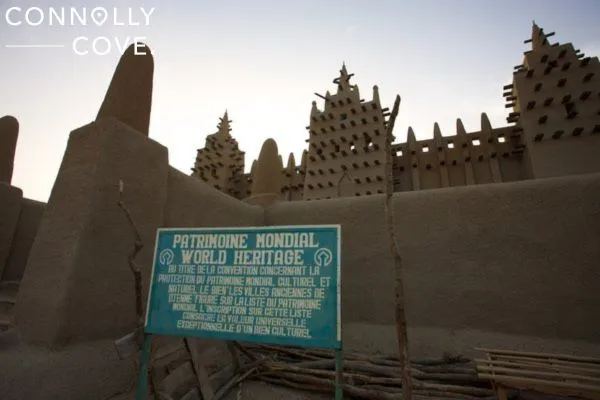
Preservation and restoration of the mud mosques in West Africa is vital to maintain their historical and cultural significance. This urgent task involves global efforts led by organisations like UNESCO, as well as local conservation activities driven by community pride and traditional expertise.
UNESCO Contributions
UNESCO has recognised the significance of these architectural marvels, with some mosques designated as World Heritage Sites. This recognition is crucial for ensuring these esteemed structures receive the funding and global attention needed for their maintenance.
For example, the Great Mosque of Djenné, a testament to the ingenuity of Mali’s traditional mud architecture, benefits from UNESCO’s advocacy and support. Not only does this help in preserving an important part of human history, but it also involves careful restoration practices that respect the original construction techniques.
Local Conservation Efforts
Local conservation efforts are equally important. These are typically spearheaded by the communities that have inherited the knowledge of ancient building techniques. They perform annual replastering ceremonies, which have been a tradition since the time of King Koi Konboro, the ruler who converted to Islam and initiated the construction of the first mosque at the site of Djenné.
Community-led initiatives not only ensure the structural integrity of the mosques but also revitalise cultural traditions, keeping the essence of these earthen structures alive through generations.
Mosques Across West Africa
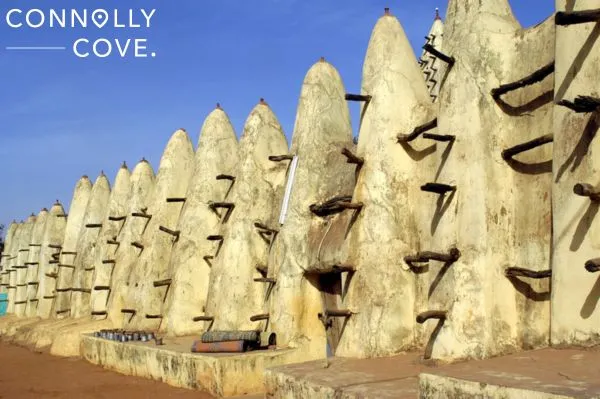
In West Africa, mosques are not merely places of worship but are also remarkable manifestations of regional architecture and cultural identity.
Regional Variations
Mosques in West Africa exhibit a rich array of styles, reflecting the diverse climatic conditions, resources, and historical influences across the region. In areas like Mali, distinctive Sudano-Sahelian architectural elements dominate, characterised by protruding wooden beams and intricately designed mud plastering. The clay or earth used in constructing these mosques not only provides a natural cooling effect but also showcases local building techniques passed down through generations.
Significant Examples
One of the most renowned examples is the Great Mosque of Djenné in Mali, revered for its majestic structure and historical significance. This world’s largest mud-brick building is a marvel of the Sudano-Sahelian architectural style.
In Ghana, the Larabanga Mosque stands as an ancient symbol of Islamic tradition, its white-washed walls gleaming under the West African sun, a beacon of spirituality for many.
Burkina Faso is home to another significant mud mosque, the Grande Mosquée de Bobo-Dioulasso, which embodies the Sahel-style architecture with its wooden sticks jutting out, serving both as decorative elements and structural supports for the building.
The modest Bole Mosque in Ghana further illustrates the earthen elegance, where communities continue to maintain its structure and significance through annual replastering, engaging in a collective act of devotion and cultural preservation.
Architecture as a Discipline
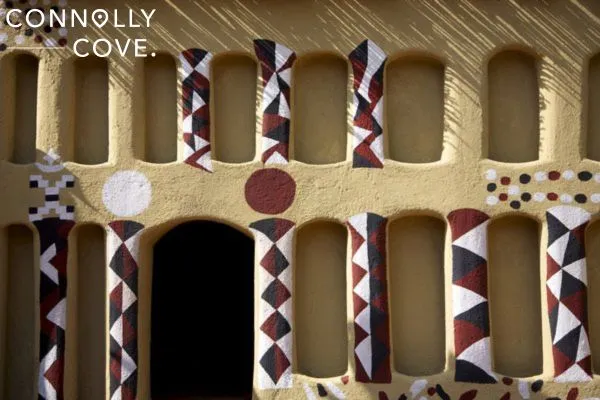
In discussing the mud mosques of West Africa, you can see the intrinsic connection between architecture and culture. Our focus is on the discipline that embodies design philosophy and the convergence of sustainability and innovation.
Design Philosophy
The design philosophy behind the mud mosques of West Africa is deeply rooted in Islamic architecture. This style is characterised by its use of geometric patterns, large courtyards, and grand arches—elements that demonstrate a profound respect for both aesthetic elegance and spiritual significance. The architects responsible for these structures employ a rich tapestry of earthen materials, aligning the majesty of their designs with the natural environment.
Sustainability and Innovation
Sustainability is pivotal to the mud mosques, where maintenance of the buildings is entwined with local community practices. Materials such as mud brick are not only abundant and eco-friendly but also insulate against the harsh Sahelian climate.
Innovation in these structures is not about high-tech solutions; it’s about adapting time-honoured techniques to ensure durability and function, such as incorporating large wooden beams for support while maintaining the integrity of the mud architecture.
Challenges and Future Outlook
The mud mosques of West Africa are remarkable symbols of cultural heritage and architectural ingenuity, yet they face significant challenges in preservation and adaptation to modern development pressures.
Preservation
These earthen structures require constant maintenance due to their vulnerability to harsh weather conditions. The traditional techniques used to build and maintain them are passed down through generations, making their preservation a matter of knowledge transfer as well. The application of these age-old techniques ensures the mosques retain their original charm and structural integrity.
- Maintenance: Yearly rituals like the Crépissage of the Great Mosque of Djenné involve the community in the repair work, reinforcing the structure and social cohesion.
- Knowledge Transfer: Ensuring younger generations learn the traditional skills is crucial for the mosques’ future. Workshops and formal training initiatives could serve as valuable platforms for such knowledge dissemination.
Commercial Development
Notably, while commercial development offers tourism revenue, it can also endanger these historical sites. Balancing economic benefits with conservation efforts is essential.
- Tourism: Increased interest can bring funds but also a strain on the local infrastructure and the structures themselves if not managed sustainably.
- Infrastructure: Careful planning is needed to ensure that necessary modernisations do not compromise the integrity of these earthen mosques.
Cultural Heritage
As symbols of local identity and pride, sustaining these mosques ensures the continuation of a living tradition. We are tasked with integrating modern methods with ancestral wisdom to safeguard these icons for future generations.
- Community Engagement: Local involvement is fundamental to both preserving the mosques and keeping the cultural heritage alive.
- Global Awareness: Bringing global attention to these wonders through information sharing and cultural exchange can help in garnering support for preservation efforts.
By adopting a confident, clear, and proactive approach, we can overcome these challenges. This will secure not just the physical structures but also the cultural narratives they embody, leaving a lasting legacy.
In conclusion, the mud mosques of West Africa stand as enduring testaments to the region’s rich cultural heritage and architectural ingenuity. These sacred structures not only serve as places of worship but also as symbols of community, resilience, and faith. With their unique blend of tradition and craftsmanship, they continue to inspire awe and reverence, preserving the cultural identity of the region for generations to come.



